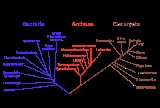
Last universal ancestor
Overview
Organism
In biology, an organism is any contiguous living system . In at least some form, all organisms are capable of response to stimuli, reproduction, growth and development, and maintenance of homoeostasis as a stable whole.An organism may either be unicellular or, as in the case of humans, comprise...
from which all organisms now living on Earth descend
Common descent
In evolutionary biology, a group of organisms share common descent if they have a common ancestor. There is strong quantitative support for the theory that all living organisms on Earth are descended from a common ancestor....
. Thus it is the most recent common ancestor
Most recent common ancestor
In genetics, the most recent common ancestor of any set of organisms is the most recent individual from which all organisms in the group are directly descended...
(MRCA) of all current life on Earth. The LUA is estimated to have lived some 3.5 to 3.8 billion years ago
Timeline of evolution
This timeline of evolution of life outlines the major events in the development of life on planet Earth since it first originated until the present day. In biology, evolution is any change across successive generations in the heritable characteristics of biological populations...
(sometime in the Paleoarchean
Paleoarchean
The Paleoarchean is a geologic era within the Archaean. It spans the period of time 3600 Ma to 3200 Ma —the period being defined chronometrically and not referenced to a specific level in a rock section on Earth. The oldest ascertained life form is from this period....
era
Era
An era is a commonly used word for long period of time. When used in science, for example geology, eras denote clearly defined periods of time of arbitrary but well defined length, such as for example the Mesozoic era from 252 Ma–66 Ma, delimited by a start event and an end event. When used in...
).
Charles Darwin
Charles Darwin
Charles Robert Darwin FRS was an English naturalist. He established that all species of life have descended over time from common ancestry, and proposed the scientific theory that this branching pattern of evolution resulted from a process that he called natural selection.He published his theory...
proposed the theory of universal common descent through an evolution
Evolution
Evolution is any change across successive generations in the heritable characteristics of biological populations. Evolutionary processes give rise to diversity at every level of biological organisation, including species, individual organisms and molecules such as DNA and proteins.Life on Earth...
ary process in his book On the Origin of Species, saying, "Therefore I should infer from analogy that probably all the organic beings which have ever lived on this earth have descended from some one primordial form, into which life was first breathed."
Based on the properties currently shared by all independently living organisms on Earth, it is possible to deduce the defining features of the LUCA.
- The genetic codeGenetic codeThe genetic code is the set of rules by which information encoded in genetic material is translated into proteins by living cells....
was based on DNADNADeoxyribonucleic acid is a nucleic acid that contains the genetic instructions used in the development and functioning of all known living organisms . The DNA segments that carry this genetic information are called genes, but other DNA sequences have structural purposes, or are involved in...
.- The DNA was composed of four nucleotideNucleotideNucleotides are molecules that, when joined together, make up the structural units of RNA and DNA. In addition, nucleotides participate in cellular signaling , and are incorporated into important cofactors of enzymatic reactions...
s (deoxyadenosineDeoxyadenosineDeoxyadenosine is a deoxyribonucleoside. It is a derivative of the nucleoside adenosine, differing from the latter by the replacement of a hydroxyl group by hydrogen at the 2' position of its ribose sugar moiety. Deoxyadenosine is the DNA nucleoside A, which pairs with deoxythymidine in...
, deoxycytidineDeoxycytidineDeoxycytidine is a deoxyribonucleoside. It is like cytidine, but with one oxygen atom removed....
, deoxythymidine and deoxyguanosineDeoxyguanosineDeoxyguanosine is composed of the purine nucleoside guanine linked by its N9 nitrogen to the C1 carbon of deoxyribose. It is similar to guanosine, but with one hydroxyl group removed from the 2' position of the ribose sugar . If a phosphate group is attached at the 5' position, it becomes...
), to the exclusion of other possible deoxynucleotides. - The genetic code was composed of three-nucleotide codons, thus producing 64 different codons.
- The DNA was composed of four nucleotide
Discussions

